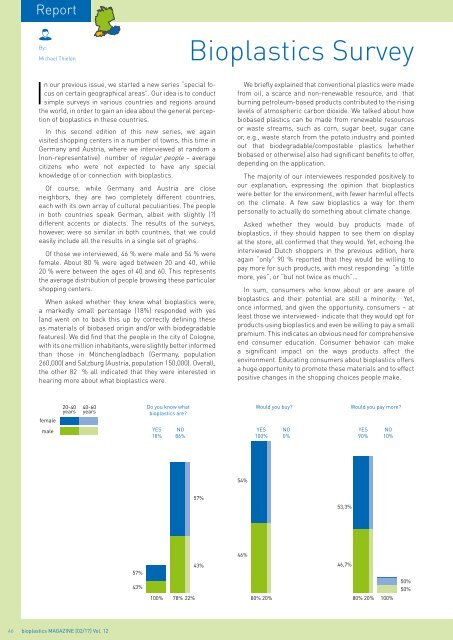Issue 02/2017
bioplasticsMAGAZINE_1702
bioplasticsMAGAZINE_1702
Create successful ePaper yourself
Turn your PDF publications into a flip-book with our unique Google optimized e-Paper software.
Report<br />
By:<br />
Michael Thielen<br />
Bioplastics Survey<br />
In our previous issue, we started a new series “special focus<br />
on certain geographical areas”. Our idea is to conduct<br />
simple surveys in various countries and regions around<br />
the world, in order to gain an idea about the general perception<br />
of bioplastics in these countries.<br />
In this second edition of this new series, we again<br />
visited shopping centers in a number of towns, this time in<br />
Germany and Austria, where we interviewed at random a<br />
(non-representative) number of regular people – average<br />
citizens who were not expected to have any special<br />
knowledge of or connection with bioplastics.<br />
Of course, while Germany and Austria are close<br />
neighbors, they are two completely different countries,<br />
each with its own array of cultural peculiarities. The people<br />
in both countries speak German, albeit with slightly (?)<br />
different accents or dialects. The results of the surveys,<br />
however, were so similar in both countries, that we could<br />
easily include all the results in a single set of graphs.<br />
Of those we interviewed, 46 % were male and 54 % were<br />
female. About 80 % were aged between 20 and 40, while<br />
20 % were between the ages of 40 and 60. This represents<br />
the average distribution of people browsing these particular<br />
shopping centers.<br />
When asked whether they knew what bioplastics were,<br />
a markedly small percentage (18%) responded with yes<br />
(and went on to back this up by correctly defining these<br />
as materials of biobased origin and/or with biodegradable<br />
features). We did find that the people in the city of Cologne,<br />
with its one million inhabitants, were slightly better informed<br />
than those in Mönchengladbach (Germany, population<br />
260,000) and Salzburg (Austria, population 150,000). Overall,<br />
the other 82 % all indicated that they were interested in<br />
hearing more about what bioplastics were.<br />
We briefly explained that conventional plastics were made<br />
from oil, a scarce and non-renewable resource, and that<br />
burning petroleum-based products contributed to the rising<br />
levels of atmospheric carbon dioxide. We talked about how<br />
biobased plastics can be made from renewable resources<br />
or waste streams, such as corn, sugar beet, sugar cane<br />
or, e.g., waste starch from the potato industry and pointed<br />
out that biodegradable/compostable plastics (whether<br />
biobased or otherwise) also had significant benefits to offer,<br />
depending on the application.<br />
The majority of our interviewees responded positively to<br />
our explanation, expressing the opinion that bioplastics<br />
were better for the environment, with fewer harmful effects<br />
on the climate. A few saw bioplastics a way for them<br />
personally to actually do something about climate change.<br />
Asked whether they would buy products made of<br />
bioplastics, if they should happen to see them on display<br />
at the store, all confirmed that they would. Yet, echoing the<br />
interviewed Dutch shoppers in the previous edition, here<br />
again “only” 90 % reported that they would be willing to<br />
pay more for such products, with most responding: “a little<br />
more, yes”, or “but not twice as much”…<br />
In sum, consumers who know about or are aware of<br />
bioplastics and their potential are still a minority. Yet,<br />
once informed, and given the opportunity, consumers – at<br />
least those we interviewed- indicate that they would opt for<br />
products using bioplastics and even be willing to pay a small<br />
premium. This indicates an obvious need for comprehensive<br />
end consumer education. Consumer behavior can make<br />
a significant impact on the ways products affect the<br />
environment. Educating consumers about bioplastics offers<br />
a huge opportunity to promote these materials and to effect<br />
positive changes in the shopping choices people make.<br />
female<br />
20-40<br />
years<br />
40-60<br />
years<br />
Do you know what<br />
bioplastics are?<br />
Would you buy?<br />
Would you pay more?<br />
male<br />
YES<br />
18%<br />
NO<br />
86%<br />
YES<br />
100%<br />
NO<br />
0%<br />
YES<br />
90%<br />
NO<br />
10%<br />
54%<br />
57%<br />
53,3%<br />
57%<br />
43%<br />
46%<br />
43%<br />
46,7%<br />
100% 78% 22% 80% 20% 80% 20% 100%<br />
50%<br />
50%<br />
46 bioplastics MAGAZINE [<strong>02</strong>/17] Vol. 12


















